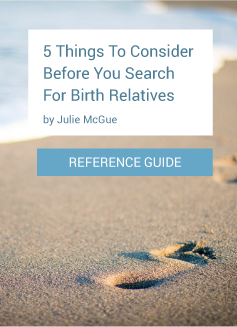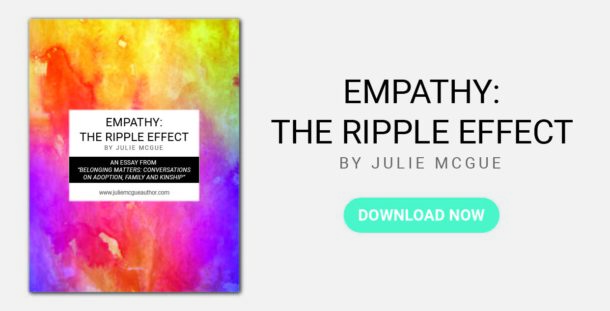The Day I Was Born Is Not The Day My Life Began

Julie McGue
Author
My birthday is coming up, and it always reminds me of what I didn’t and couldn’t know.
No one remembers the day they were born. We rely on recollections from our parents and family to reconstruct what happened. And, if we’re lucky, there’s a family photo album or baby book to drag out from the attic. Maybe the dusty tome shows a joyful but exhausted smile on Mom’s face, the beaming pride that squares Dad’s shoulders, or Grandma sandwiching a dozing infant in the sweet spot babies adore–the warm crevice between a voluminous, beating breast and a hefty midline.
Absent the baby book, there are the stories that families enjoy rehashing–the repetition of which can annoy us into adulthood. Mom describes how big her belly was when she was pregnant, her terrible heartburn, the swelling in her ankles, her unexpected nausea when smelling seafood, or her insatiable craving for Dove bars. Dad expounds on the frantic drive to the hospital, how that particular January morning was the coldest day of the year, or how a traffic jam almost prevented them from arriving at the hospital in time.
If you’re an adoptee, like me, from the closed adoption era–that period in adoption history after WWII through the 1980s–when adoptive parents received little or no information about their child’s birth circumstances or background, then unfortunately there are no skin-to-skin contact pictures or driving-to-the-hospital-just-in-time stories to share.
My State of Illinois Certificate of Live Birth is redacted. Once my adoption was finalized in the fall of 1959, my adoptive parents’ information replaced the details of my birth parents, and then the original birth record was sealed in the archives of the Illinois Department of Vital Statistics. Other than the date and time of my birth, no other identifying information made it through the closed adoption sanitation process.
The day I was born was clouded in so much mystery, it’s almost as if it didn’t happen.
When my adoptive parents collected my twin sister and I from St. Vincent’s Orphanage in Chicago on March 6, 1959, we were already three weeks old. And, other than being told that we were fraternal twins–a DNA test in 2011 proved that we are in fact identical twins–and that we had already been baptized, nothing was shared with them about our background or birth circumstances. For the better part of my life, I have speculated and conjured up fantasies about the day I was born–a day most people consider as one of the most significant moments in their lives.
Even though my physical life began on February 11, 1959, my family life wasn’t created until March 6, 1959. Current adoption terminology refers to this special day as Adoption Day. In my family, the date of my adoption was not something that we recognized or commemorated. Not because it wasn’t meaningful, it just wasn’t a thing. Transparency in the adoption experience and positive adoption language both came into vogue in the 1980s when open adoption gained prevalence.
So, instead of the play-by-play of what happened on the day my twin sister and I were born, what transpired on Adoption Day is the family legend which has trailed me in to adulthood. I know that my adoptive parents pulled their sedan out of the detached garage behind their two-bedroom ranch in Western Springs and merged onto the Eisenhower expressway for the twelve-mile trip into Chicago. Once they arrived on the city’s Gold Coast, my folks parked in the private lot behind the massive, red-brick structure at 721 N. La Salle Street. Grinning with joy and shivering with new parent nerves, Mom and Dad took the elevator from the lobby to the fifth floor. Upon exiting, they were met by Sister Mary Alice Rowan, the renowned prioress of St. Vincent’s Infant & Child Home. She ushered them into her office where they signed our adoption paperwork and received our baptismal certificates. And then, they followed the winged-hat Sister of Charity down a glistening linoleum hallway to the ‘waiting for adoption’ infant nursery. From behind a huge plate glass window, they beamed at the sight of my twin sister and me, swaddled in pink blankets, and in the arms of two nurse’s aides. When Sister Mary Alice gave the nod to her staff, the young women emerged from the nursery and placed us into our parents’ waiting arms. This was the day my life began.
When Illinois adoption law changed in 2011, I was allowed access to my OBR, the unredacted version of my birth circumstances. That same year I found and connected with my birthmother. I chronicle the search story in my debut memoir, Twice a Daughter: A Search for Identity, Family, and Belonging, which will be released in May by She Writes Press. I was 52 when I met my birth mother and she shared with my twin sister and me what happened on the day we were born. Filling in the details of my personal puzzle was a thrilling and satisfying moment–the fulfillment of a lifelong yearning.
Mark Twain is credited with saying, “The two most important days in your life are the day you were born and the day you find out why.” I agree with Twain. Those two moments are vital to self-knowledge and personal development. But as an adoptee, I have a third important day. Adoption day. The day I became my parents’ daughter, which is the day my life began.
“The day I was born was clouded in so much mystery, it’s almost as if it didn’t happen.”
Before you begin your search for your birth relatives…
Snag my in-depth reference guide to best equip you for the journey ahead.




I look forward to reading your book. You have quite a powerful story to share.